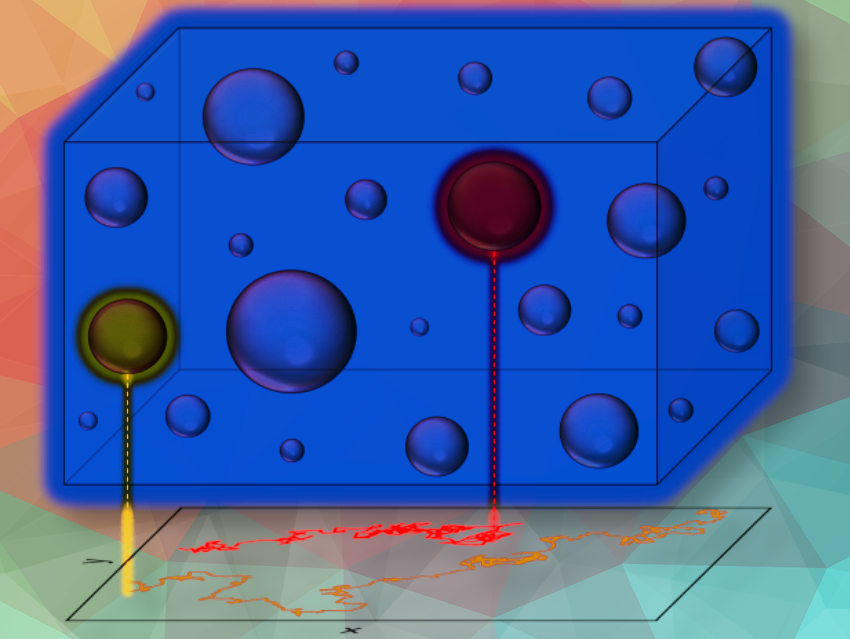Nanobubbles, sub-micron-sized gas entities used across various scientific fields, are generally believed to diffuse via Brownian motion. However, Evangelos Bakalis, Universita di Bologna, Italy, and colleagues report their self-propelled motion in ultrapure water at body temperature.
Nanobubbles are used in various scientific and industrial applications, including water and wastewater treatment, where they increase adsorption kinetics and capacity for contaminants; agriculture, where they improve growth rates of plants, fish, and other organisms in water solutions; and medicine, where they increase imaging contrast, drug delivery, and cancer treatments through ultrasonics and therapeutic delivery mechanisms.
What did you do?
We employed Nanoparticle Tracking Analysis (NTA), a widely used light scattering technique, which was originally designed to determine the concentration and size distribution of sub-micron-sized entities suspended in a liquid medium, to investigate the diffusional behavior of individual oxygen bulk nanobubbles (NBs) in ultrapure water.
Why are you doing this?
Oxygen NBs in water show various intriguing properties, including long-term stability, high surface charge, and large gas transfer capacity. Gaining insight into their dynamics in aquatic environments at body temperature could improve our understanding of their potential uses in medicine.
What is new and cool about it?
Nanobubbles can behave as active particles through self-propulsion, using environmental fluctuations and forming memory, which allows them to move faster than classical Brownian particles. Despite reports of NB motion deviating from Brownian motion, the assumption in the field that an NB is a Brownian particle is widely used to estimate various properties of NBs.
In this work, we have demonstrated that oxygen NBs in water can self-propel by using sophisticated mathematical analysis techniques on individual NBs’ trajectories captured by the NTA technique.
What are your key findings?
Through extended tracking of individual oxygen nanotubes (NBs), we have demonstrated that most of them deviate from Brownian motion; in fact, NBs can self-propel, and their diffusional behavior is independent of the tracking time.
What specific applications do you imagine?
This work represents a first attempt to expand the use of NBs in applications where first passage time is important. For example, in applications where it is desirable to release encapsulated gas at predetermined targets, such as the treatment of tumor hypoxia.
External agents, such as ultrasound excitation, can only effectively trigger the release of encapsulated chemicals only upon reaching the target. This requires different average times depending on the nature of the diffusion process. Ultimately, to optimize the yields, the triggering of the collapse of the nanobubble must be based on the knowledge of the position of the carrier.
What part of your work was the most challenging?
Analyzing the motion of the nanobubbles in ultrapure water was an unconventional approach, as it was previously believed that their motion was Brownian. Overall, there were no particularly difficult aspects of the research process.
If we had to pick one, it would be establishing a protocol that guarantees that the nanoparticles observed are indeed nanobubbles. We refined our nanobubble production protocol to reduce the risk of contamination. That is, we used ultrapure water to clean the nanobubble generator and associated equipment, ran the system repeatedly to remove impurities, and produced nanobubble-containing water by introducing pure oxygen.
Thank you for sharing these insights.
The paper they talked about:
- Nanobubbles in Ultrapure Water Can Self-Propel,
Evangelos Bakalis, Pavlos Efthymiopoulos, Francesca Lugli, Athanasios Ch. Mitropoulos, George Z. Kyzas, Francesco Zerbetto,
ChemPhysChem 2024.
https://doi.org/10.1002/cphc.202400508
Evangelos Bakalis is a researcher on the tenure track at the Dipartimento di Chimica ‘G. Ciamician’ at the Università di Bologna in Italy.
His research spans physics, chemistry, biology, biochemistry, material sciences, social sciences, and geosciences, with a focus on stochastic analysis. His work addresses phenomena out of equilibrium, including diffusive motion in confined environments, noise and memory effects, network interactions, time series analysis, and enzymatic kinetics.




